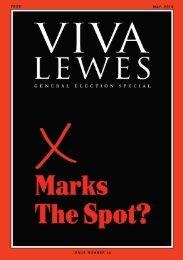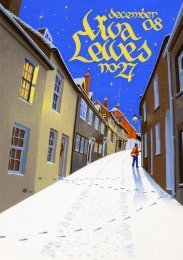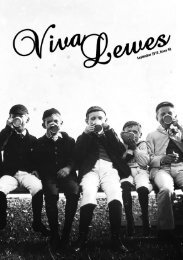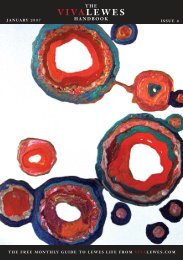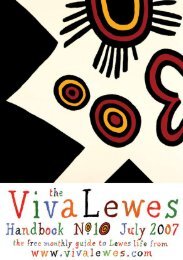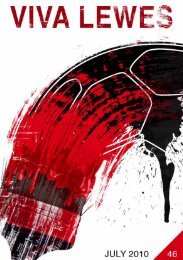01273 302170 www.staubynsschoolbrighton.co.uk - Viva Lewes
01273 302170 www.staubynsschoolbrighton.co.uk - Viva Lewes
01273 302170 www.staubynsschoolbrighton.co.uk - Viva Lewes
Create successful ePaper yourself
Turn your PDF publications into a flip-book with our unique Google optimized e-Paper software.
<strong>www</strong>.viva<strong>Lewes</strong>.CoM<br />
my space: richie JarviS’ obServatory<br />
In the back garden of his house in South Chailey,<br />
amateur astronomer Richie Jarvis has his own<br />
observatory, where he takes photos of stars, planets<br />
and galaxies.<br />
It was my ex-wife’s fault I got into astronomy.<br />
She was doing an Open University <strong>co</strong>urse in science,<br />
part of it was in astronomy and I was interested from<br />
a kid, but I’d never even looked through a teles<strong>co</strong>pe.<br />
We went out and bought a teles<strong>co</strong>pe, one of the<br />
cheap little two-inch ones from one of those nature<br />
shops. Its tripod was so badly made I <strong>co</strong>uldn’t steadily<br />
see a planet, it would just wobble. But I looked at<br />
Saturn, and that was it. ‘I’ve got to get a bigger one’.<br />
As a divorce present, I bought an 8-inch teles<strong>co</strong>pe<br />
that I had absolutely no idea how to use.<br />
It would follow the sky, on an equatorial mount,<br />
which tracks the direction of the earth’s rotation,<br />
and <strong>co</strong>unteracts for it, so as the earth rotates the<br />
teles<strong>co</strong>pe stays still relative to the sky.<br />
My current teles<strong>co</strong>pe is <strong>co</strong>nnected to the <strong>co</strong>mputer.<br />
You fire up the Planetarium software, and just<br />
say ‘point to that star’. It knows exactly where that<br />
is, what time it is, and it knows the exact position of<br />
that teles<strong>co</strong>pe right now. Knowing that, and some<br />
<strong>co</strong>mpensation <strong>co</strong>-ordinates, I can tell it to look at<br />
anything.<br />
The moon is the biggest source of light pollution<br />
in the night sky. You can’t do deep-sky photography<br />
My wiLdLiFe sPaCe<br />
when the moon is full, because you’d need to leave<br />
the shutter open for 10-15 minutes, and the moon<br />
will just wash the picture out.<br />
When you see stars twinkling, that’s because<br />
the atmosphere is moving around, and diffracting<br />
all the light around, showing you rainbow <strong>co</strong>lours.<br />
That’s a real problem because it just blurs the image.<br />
You’re looking for a night when the atmosphere is<br />
very steady, and that’s when you take pictures of the<br />
Moon, and Jupiter and Saturn.<br />
When you’re using a camera, you’ll typically put<br />
the SLR directly on the teles<strong>co</strong>pe, which acts<br />
like a lens. My main imaging camera is monochrome,<br />
and I use filters to build up a <strong>co</strong>lour image.<br />
Hydrogen is the most <strong>co</strong>mmon element in the<br />
universe, and it glows red, so pictures end up too red<br />
otherwise.<br />
We’re very, very, very tiny. To map out the solar<br />
system with the Earth as a ping-pong ball, the sun<br />
would have to be about 4.5m in diameter. At the<br />
scale of a ping pong ball as the sun, it’s 129 metres<br />
to Neptune! Jupiter is the size of a pepper<strong>co</strong>rn, and<br />
Saturn is about the size of a small ball bearing. You<br />
cannot represent the rest of the planets in the Solar<br />
System, at that scale, because they’re too small.<br />
You’re not talking pinhead, you’re talking the sharp<br />
end of the pin. As told to Steve Ramsey<br />
You can see Richie’s photos on his website, nebul.ae<br />
67<br />
Photo montage by Katie Moorman



